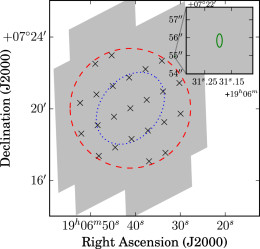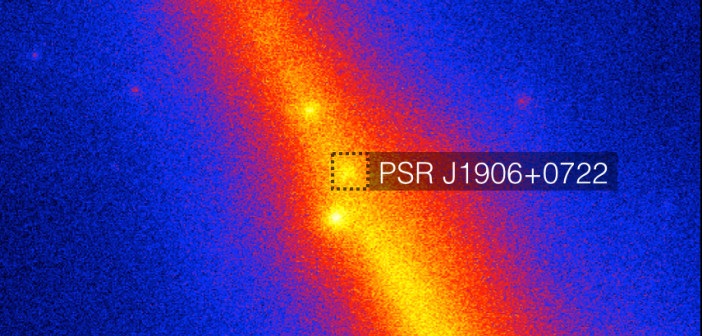Since the release of the second Fermi-LAT catalog in 2012, astronomers have been hunting for 3FGL J1906.6+0720, a gamma-ray source whose association couldn’t be identified. Now, personal-computer time volunteered through the Einstein@Home project has resulted in the discovery of a pulsar that has been hiding from observers for years.
A Blind Search
Identifying sources detected by Fermi-LAT can be tricky: the instrument’s sky resolution is limited, so the position of the source can be hard to pinpoint. The gamma-ray source 3FGL J1906.6+0720 appeared in both the second and third Fermi-LAT source catalogs, but even after years of searching, no associated radio or X-ray source had been found. A team of researchers, led by Colin Clark of the Max Planck Institute for Gravitational Physics, suspected that the source might be a gamma-ray pulsar. To confirm this, however, they needed to detect pulsed emission — something inherently difficult given the low photon count and the uncertain position of the source.
The team conducted a blind search for pulsations coming from the general direction of the gamma-ray source. Two things were needed for this search: clever data analysis and a lot of computing power. The data analysis algorithm was designed to be adaptive: it searched a 4-dimensional parameter space that included a safety margin, allowing the algorithm to wander if the source was at the edge of the parameter space. The computing power was contributed by tens of thousands of personal computers volunteered by participants in the Einstein@Home project, making much shorter work out of a search that would have required dozens of years on a single laptop.

The sky region around the newly discovered pulsar. The dotted ellipse shows the 3FGL catalog 95% confidence region for the source. The data analysis algorithm was designed to search an area 50% larger (given by the dashed ellipse), but it was allowed to “walk away” within the gray shaded region if the source seemed to be at the edge. This adaptive flexibility is what allowed the pulsar’s actual location — shown by the solid ellipse, inset — to be found. [Clark et al., 2015]
Teasing the Signal From Misinformation
This new search method turned out to be exactly what was needed: the team was able to identify pulsed emission coming from a point located significantly outside of the source’s original confidence region. This source, now named PSR J1906+0722, has been determined to be a young, energetic, isolated pulsar, and the team was able to identify its spin parameters and pulse history from the last six years.
So why was this mysterious pulsar so hard to find? Its misidentified position, most likely due to a secondary source that had been lumped with the pulsar into a single source, was the biggest factor. Additionally, the pulsar had an enormous glitch one year into Fermi observations of it, making it even more difficult to pin down its pulse profile.
The team’s success in spite of these complications indicates the value of their methods for identifying other young, gamma-ray, radio-quiet pulsars that are likely hidden in the Fermi-LAT catalog.
Citation
C. J. Clark et al. 2015 ApJ 809 L2 doi:10.1088/2041-8205/809/1/L2


1 Comment
Pingback: Einstein@Home Finds an Elusive Pulsar | A cielo...